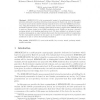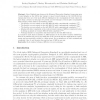CANS
2011
Springer
12 years 11 months ago
2011
Springer
Abstract. In this paper we analyze the recently proposed light-weight block cipher PRINTCipher. Applying algebraic methods and SAT-solving we are able to break 8 rounds of PRINTCip...
CANS
2011
Springer
12 years 11 months ago
2011
Springer
In this paper, we explore fast algorithms for computing on encrypted polynomials. More specifically, we describe efficient algorithms for computing the Discrete Fourier Transform,...
ASIACRYPT
2011
Springer
12 years 11 months ago
2011
Springer
We provide constructions of (m, 1)-programmable hash functions (PHFs) for m ≥ 2. Mimicking certain programmability properties of random oracles, PHFs can, e.g., be plugged into ...
ASIACRYPT
2011
Springer
12 years 11 months ago
2011
Springer
Differential Privacy (DP) has emerged as a formal, flexible framework for privacy protection, with a guarantee that is agnostic to auxiliary information and that admits simple ru...
ASIACRYPT
2011
Springer
12 years 11 months ago
2011
Springer
We present a generic method to secure various widely-used cryptosystems against arbitrary side-channel leakage, as long as the leakage adheres three restrictions: first, it is bou...
ASIACRYPT
2011
Springer
12 years 11 months ago
2011
Springer
ARMADILLO2 is the recommended variant of a multi-purpose cryptographic primitive dedicated to hardware which has been proposed by Badel et al. in [1]. In this paper we propose a me...
ASIACRYPT
2011
Springer
12 years 11 months ago
2011
Springer
We propose a lattice-based functional encryption scheme for inner product predicates whose security follows from the difficulty of the learning with errors (LWE) problem. This co...
ASIACRYPT
2011
Springer
12 years 11 months ago
2011
Springer
The assumption of the availability of tamper-proof hardware tokens has been used extensively in the design of cryptographic primitives. For example, Katz (Eurocrypt 2007) suggests ...
ASIACRYPT
2011
Springer
12 years 11 months ago
2011
Springer
A fundamental question in cryptography deals with understanding the role that randomness plays in cryptographic protocols and to what extent it is necessary. One particular line o...
ASIACRYPT
2011
Springer
12 years 11 months ago
2011
Springer
Since Rijndael was chosen as the Advanced Encryption Standard, improving upon 7-round attacks on the 128-bit key variant or upon 8-round attacks on the 192/256-bit key variants has...


